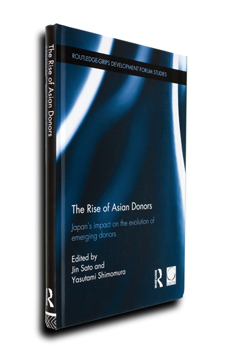書籍紹介
Jin Sato and Yasutami Shimomura, eds. The Rise of Asian Donors: Japan's Impact on the Evolution of Emerging Donors(Routledge-GRIPS Development Forum Studies).
著者からの紹介

新著「アジアの新興援助ドナーと日本のインパクト」
かつて援助を受けていた貧しい被援助国は、どのようにして援助国化していくのか。援助を受けた経験は、援助を送り出す手法にどう反映されるのか。本書は、被援助国から援助国へと転換していった日本を含むアジア諸国を事例に、こうした問いに答える目的で書かれました。
まず第1部で日本の援助国化プロセスを詳細に検討しています。そこでは、1950年代における世界銀行による対日援助、米国による対日援助を詳細に検討し、その経験が日本のドナー化にどう変換されたのかを考察しました。第2部は、もっと最近の事例から日本から援助を受けて経済成長を果たし、今ではドナーの一角を占めるようになった中国、韓国、インドを材料に、被援助経験が援助国化のプロセスに与える影響を検討してみました。ODA(政府開発援助)が尻すぼみになりつつある今日、援助の歴史を振り返ることは、新しい国際協力を展望する上で最も確かな縁になるに違いありません。ぜひ御笑覧いただき、御批判いただければと思います。
佐藤 仁
Introduction
Why do poor countries give aid to others? This book critically examines how aspirations for providing aid have coexisted with experiences of receiving aid and have transformed the practice of giving aid, with particular reference to the experiences of Japan and China. It highlights the historical sources that explain the pattern and strength of foreign aid that these new donors provide.
The book has systematically examined the situation unique to middle income countries that are receiving and giving aid simultaneously. It sheds light on the endogenous elements embedded in the socio-economic conditions of emerging donors, as well as their learning process as aid recipients. This book examines not only the perspectives of recipients, but also those of donors: Japan in the case of China, and the USA and the World Bank in the case of Japan. By bringing in the donor’s perspective, we come to a holistic understanding of foreign aid as a product of interaction between the various agents involved. The book provides not only an in-depth case study of Japan from a historical perspective, but also stretches its scope to cover contemporary debates on "emerging donors," including China, India and Korea who have received substantial amount of aid from Japan in the past. This book connects the often separated discussion of Japanese aid and the way it developed in relation to outside forces.
In short, this book represents the first attempt to empirically examine the "life of a donor" with a clear focus on the origins, struggles, and futures of non-western donors and their impact on established aid regime.
Contents
| 1. Introduction: aiding development - how does recipient experience count? JIN SATO | |
|---|---|
Part 1: Japan's emergence from a recipient to a donor | |
| 2. | Domestic functions of economic cooperation: Japan's evolution as a donor in the 1950s JIN SATO |
| 3. | How US aid in the 1950s prepared Japan as a future donor TOSHIHIRO HIG UCHI |
| 4. | Technology transfer and technology development in post-World War II Japan triggered by World Bank projects MIKIYASU NAKAYAMA AND RYO FUJIKURA |
| 5. | World Bank Regional Development Projects in Japan: two pilot farm projects, 50 years later RYO FUJIKURA AN D MIKIYASU NAKAYAMA |
Part 2: The rise of emerging donors and Japan's impact | |
| 6. | Donors' impact on China: How have major donors affected China's economic development and foreign aid policy? SHINO WATANABE |
| 7. | The evolution of "aid, investment, trade synthesis" in China and Japan YASUTAMI SHIMOMURA AND WANG PING |
| 8. | Korea's pathway from recipient to donor: How does Japan matter? HISAHIRO KONDOH |
| 9. | Role of Japan in the evolution of Indian aid policy HIROAKI SHIGA |
| Conclusion YASUTAMI SHIMOMURA | |
| Index | |
情報
Jin SATO and Yasutami Shimomura, eds.
"The Rise of Asian Donors: Japan's Impact on the Evolution of Emerging Donors
"
(Routledge-GRIPS Development Forum Studies), 200 pages
2012年9月
佐藤仁准教授の著作
東洋文化研究所にて過去に紹介した佐藤准教授によるその他の刊行物
- 佐藤 仁 著 『「持たざる国」の資源論』
- Edited By Jin Sato, Transboudary Resources and Environment in Mainland Southeast Asia
東洋文化研究所教員の著作

